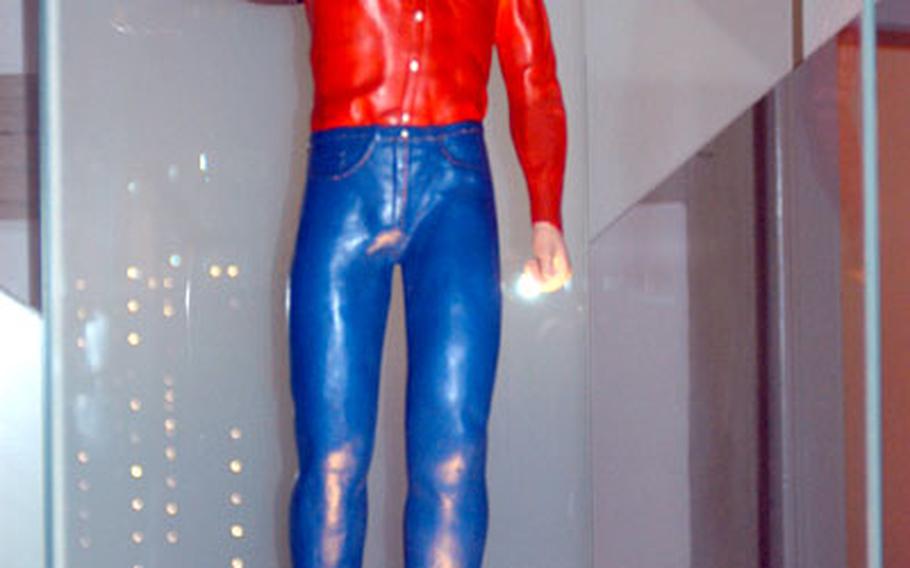
A statue of the “saddle man.” a longtime symbol for Levi’s, stands the Levi Strauss Museum in Buttenheim, Germany. (Stars and Stripes)
One of the iconic symbols of Americana is enshrined in a museum in a small town in Bavaria.
The Levi Strauss Museum in Buttenheim, Germany, tells the story of the creation of Levi’s jeans and the life of Strauss, who was born Loeb Strauss in the small town on Feb. 26, 1829.
The exhibit can be viewed with the aid of a hand-held audio device that can be set to several languages, including English. It talks about Strauss’ life in Germany, his emigration to the United States and how his name became linked to a popular pair of pants.
The museum, in Strauss’ renovated childhood home, looks much like any other building on the town’s main street, save for its blue-and-white paint and a large sign in front of it.
Built in the 1790s, it was home to several generations of the Strauss family, whose ancestry has been traced to 1450. Loeb, who changed his name to Levi to sound more American after emigrating to the States, was one of five children, although only a sister and he shared the same mother.
When his father, Hirsch, died in the mid-1840s, the family moved in with an uncle. When the uncle died just a few months later, the survivors applied for passports and approval to emigrate to the United States, where Levi’s half- brothers lived.
The Strausses were allowed to take only luggage, and had to sell most of their belongings. A 13- week voyage from Bremerhaven ended in New York, where Levi, then 16, helped run a dry goods store before moving to California.
In 1853, Strauss opened a store in San Francisco and began selling fabric and other items needed by miners seeking their wealth in gold. Twenty years later, tailor Jacob Davis approached Strauss for financial support to get a patent for a rivet he designed to reinforce the stress points of trousers, particularly the pockets.
In 1873, Davis and Strauss received a joint patent on the rivet, and began making work overalls for miners, farmers and industrial workers. The trousers were an instant hit, and quickly made Strauss and Davis rich.
There were only a few changes as the original work trousers evolved into the blue jeans of today. Belt loops were added in the 1920s. Zippers replaced the button fly in the 1950s. Rivets were removed from the back pockets in the 1960s. Additionally, in the early 1900s, a synthetic form of indigo was used to color the trousers.
When Strauss, who started several charitable organizations in San Francisco, died in 1902, his nephews had already assumed most of the control of his company. Davis pulled out when the San Francisco earthquake destroyed the company’s factory. But Strauss’ nephews rebuilt and expanded the factory.
The tour narrator, as well as a Western-accented voice that represents Strauss, explains everything to museum visitors from the Strausses’ trip to America and their early days in New York to Levi’s move to San Francisco and the evolution of blue jeans into the 20th century.
The museum, which opened in 2000, covers three stories and includes the display of a private collection of Levi’s dating back more than 50 years. The museum also has a gift shop at street level.
On the QT …
Directions: Take Autobahn 73 south toward Nuremberg and exit at Buttenheim. Turn left at the second street toward Buttenheim, staying on the priority road until reaching the three- story, blue-and- white Levi Strauss Museum on the left side of Marktstrasse.
A large sign stands in front of the house, and parking is available on the street. From Bamberg, it is less than a 20-minute drive.
Hours: From Nov. 1 to Feb. 28, the museum is open 2-5 p.m. Tuesdays and Thursdays, and 11 a.m. to 5 p.m. weekends and holidays; during the rest of the year, it remains open until 6 p.m. on Tuesdays and Thursdays.
Costs: Admission is 2.60 euros for adults and 1.30 euros for children and students. Group rates require advance notification and are 2 euros per person.
Food: There are several restaurants in Buttenheim, including Jürgen’s Bistro and the St. George beer cellar. Probably most popular is the Löwenbrau beer cellar and restaurant. The restaurant serves traditional Fränkisch dishes, such as white beans with dumplings — as well as its popular Löwenbrau beer. The cellar is open 11 a.m. to 2:30 p.m. Tuesday to Sunday, and 4-9 p.m. for dinner.
Information: For information about the museum, call (+49) (0) 9545-442602 or (+49) (0) 09545-4409936. Its Web site is www.levi-strauss-museum.de/index.html.
There is an English-language site at www.levi-strauss-museum.com, but it has considerably less information about the museum than the German-language site.
— Rick Emert